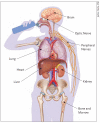Inhalant use and inhalant use disorders in the United States
- PMID: 22003419
- PMCID: PMC3188822
Inhalant use and inhalant use disorders in the United States
Abstract
More than 22 million Americans age 12 and older have used inhalants, and every year more than 750,000 use inhalants for the first time. Despite the substantial prevalence and serious toxicities of inhalant use, it has been termed "the forgotten epidemic." Inhalant abuse remains the least-studied form of substance abuse, although research on its epidemiology, neurobiology, treatment, and prevention has accelerated in recent years. This review examines current findings in these areas, identifies gaps in the research and clinical literatures pertaining to inhalant use, and discusses future directions for inhalant-related research and practice efforts.
Figures



References
-
- American Psychiatric Association . Diagnostic and Statistical Manual of Mental Disorders. 4th Edition. Washington, D.C.: American Psychiatric Press; 2000.
-
- Anderson CE, Loomis GA. Recognition and prevention of inhalant use. American Family Physician. 2003;68(5):869–874. 876. - PubMed
-
- Anthony JC, Warner LA, Kessler RC. Comparative epidemiology of dependence on tobacco, alcohol, controlled substances, and inhalants: Basic findings from the National Comorbidity Survey. Experimental and Clinical Psychopharmacology. 1994;2(3):244–268.
-
- Avella J, Wilson JC, Lehrer M. Fatal cardiac arrhythmia after repeated exposure to 1,1-difluoroethane (DFE) American Journal of Forensic Medicine and Pathology. 2006;27(1):58–60. - PubMed
-
- Bale AS, et al. Alterations in glutamatergic and gabaergic ion channel activity in hippocampal neurons following exposure to the abused inhalant toluene. Neuroscience. 2005;130:197–206. - PubMed
Publication types
MeSH terms
Grants and funding
LinkOut - more resources
Full Text Sources
Medical
